SPOILER ALERT: we didn’t die!
This passage has been our main focus for the last two months. The trip was supposed to be from Puerto Rico, but it is a couple hundred miles longer from there which means that the weather must be good for a bit longer. So, we went south to Bonaire and Curaçao to break it up a bit. That turned out to be a perfect strategy.
Why Panama? Well, aside from our very good friends on Low Expectations living there aboard their boat while building up a vacation island that they purchased several years back, western Panama is slightly outside the worst of the summertime lightning zone and well south of the hurricane belt. It is inexpensive, has a rich culture, beautiful countryside and friendly people. Also important to us is that if we end up heading to the South Pacific, we need to be here by the fall anyway to get any final work done on the boat and head through the canal.
The trip was 898 nautical miles long, which is just over 1,033 miles. Our longest trip to date had been about 450 miles. We had gone 400-450 three times before but this was going to be more than double that. We have been on four-day-long passages five times, but this was looking like 7-8 days unless we went really fast.
We had a nice leisurely departure from Curaçao after breakfast and Dramamine. Mamita was taking a route south of Aruba but we went north and stayed well north of the Colombian coast. The trade winds and associated seas get funneled between Hispaniola far to the north and the cape at the north end of Colombia and can make for very rough, even treacherous conditions.
Steering
Within the first fifty miles, our steering started getting loud. I went into the lazarette to have a look at the steering cables, quadrant, and cable sheaves. It was apparent right away that the noise was coming from the sheaves and I was concerned since while underway we can’t exactly stop steering and we had a very long way to go. Immediately I was thinking we might need to pull in to Aruba in order to assess and repair but I kept looking and being careful not to put my little meat mittens in between moving metal parts since I really like having ten fingers.
I was able to access the sheaves from Dublin’s bed and I did the best I could hosing them down with white lithium grease. Within a minute or two, the noise got quiet and actually stayed that way until the last hour or so of the underway. Clearly I need to clean and service them in port but it was great that we got through the passage in good shape.
Wind and Waves
So, the reason we needed the weather to be just right is not necessarily just that we don’t want too much wind. Actually, if heading downwind, we have found that 20-25 knots of wind (25-30mph) is actually comfortable and gives us quite a bit of speed. The trouble is that in this area, the wind will stay at 25-30 knots and gust to 35-40 knots if not timed right. That is a lot of power and can be utterly terrifying if you have too much sail out.
Additionally, wind = waves, unless there is land blocking the waves from the windward side, which we would only have for the first 30 miles or so until we passed the northernmost part of Curaçao. For every ten knots of wind, the wave height goes up by roughly one meter. So 25 knots of wind means 8 foot waves, as the baseline. There is also left over swell from previous wind, and reflection/refraction along the cape. On this trip we saw waves up to about 12 feet which for the most part isn’t too big of a deal, but every once in a while the timing can be just wrong and make things quite uncomfortable, scary, and even dangerous.
The combination of high wind and high seas coming from astern meant that we were able to sail with our headsail to leeward and our mainsail (tied toward the bow with a preventer) to windward. This is called sailing “goose-winged”, or “wing on wing” and means that neither sail blocks the wind from the other and you get to harness quite a bit of power while keeping the boat really well balanced. The waves momentarily slow the boat as they approach, and then rapidly accelerate the boat as you ‘surf’ down them. It is exhilarating and makes for really good speeds on the average. Add to that the fact that a 1-1.5 knot current was in our favor and we saw speeds that we never imagined in our boat before.
Before this trip the fastest we had seen was 9.2 knots. The design characteristics and size of our boat mean that we have an 8.21 knot hull speed. This is the maximum speed the boat can reach before the force required for more speed goes up significantly for each small increase to speed.
On this trip seeing 9+ or even 10+ became pretty common. We often pushed into the elevens and on one wave on our third day out we peaked at 12.7 knots, the fastest I imagine we will ever see on the Hoss.

The Scary Parts
Of course, after a few days at those speeds we were numb to it but the first 24 hours were exhausting because it was scary to go so fast. Also for each passing wave that pushes us along, it isn’t a perfect push. We get spun slightly sideways sometimes, or secondary swell comes from a different direction and hits the side of boat sending water flying all over us. We were wet and on edge non-stop.
At night, around 11pm or so, I was sleeping on the floor of the cockpit while Grete was at the helm for her watch. We had been getting the occasional splash from waves every hour or so but it was mostly just uncomfortable. I awoke to a loud roaring sound that was loud and getting much louder. Not the gentle wake-up of pancakes and coffee in bed I would have preferred. The roaring finally peaked as a wave blasted right over the side of our boat into our cockpit, completely flooding (or pooping) our cockpit. It was like being the coach of a dozen teams that just won the super bowl. I got completely soaked. Grete got it much worse since she was sitting up at the wheel not lying down on the floor like I was. The wave hit her like a wall and knocked her into into our arch railing and lifelines on the other side of the cockpit. She has a nasty bruise now and in the moment as I woke up, I saw that her face was completely petrified.
Even though I was scheduled for another hour of sleep, I didn’t feel like Grete was mentally ready to sit awake alone in the dark for another hour so I took the watch to let her get cleaned up, changed into dry clothes and lying down below in the cabin for a few hours to recover.
We got pooped one more time on the underway but it was far less scary and happened just before sunset while we were enjoying some burgers from the grill. I somehow managed to not get very wet but Grete and the kids got drenched. They all got cleaned up and into dry clothes and we called it a night for the kids.
I think that was the second night out and after that the seas calmed down to around six feet to maybe eight feet max and no more poopings occurred outside the toilet.
She Should Run for Mayor
It has been a long-standing joke between Grete and I that she knows everyone. Sometimes I can walk around in my own house and not see anyone I know. When I taught, I could go all over campus all day and never see anyone I knew despite the fact that I had taught hundreds of students that presumably were there somewhere.
Grete, on the other hand, knows people everywhere. We would go downtown to anything, or go shopping, and obviously bump into someone she knows.
The pinnacle of ridiculousness was when we went to Yosemite a few years back and were hiking up a random trail that isn’t very crowded and happened upon someone she knew. Coincidentally, we were at Yosemite with several friends of mine who hiked the same trail and never saw them.
But now it has been beat. We were about 100 miles from land just sailing along when I heard someone hail us over the VHF radio, “Sea Horse, this is Inuksuit…”. I replied and we discussed what collision avoidance turns we would make since according to AIS we were going to pass within 100 yards of each other. After we figured it out, the woman asked, “Is your wife Grete?” Hahahahahahahaa. Apparently Grete had been chatting with the woman from the other boat on WhatsApp a few days before for some random reason. So we almost collided with someone Grete knew a hundred miles from nowhere. I think short of bumping into someone on the moon, this will be hard to beat.
Prepared
In all of our preparations, part of the route guidance process I do is to check the path so that I know what kinds of hazards we can expect to encounter. Since for the majority of the trip we were going to be well offshore in water over 5,000 feet deep, I didn’t zoom in very closely on much of our route. If I had done so, I would have realized that I have never downloaded the charts for the deep ocean portion of our trip. It’s not something that actually matters, we had charts for any time we were within a hundred miles of shore, but it was still something Grete was griping about. I told her it wasn’t important since I was wearing a ‘paper’ chart as a backup :)
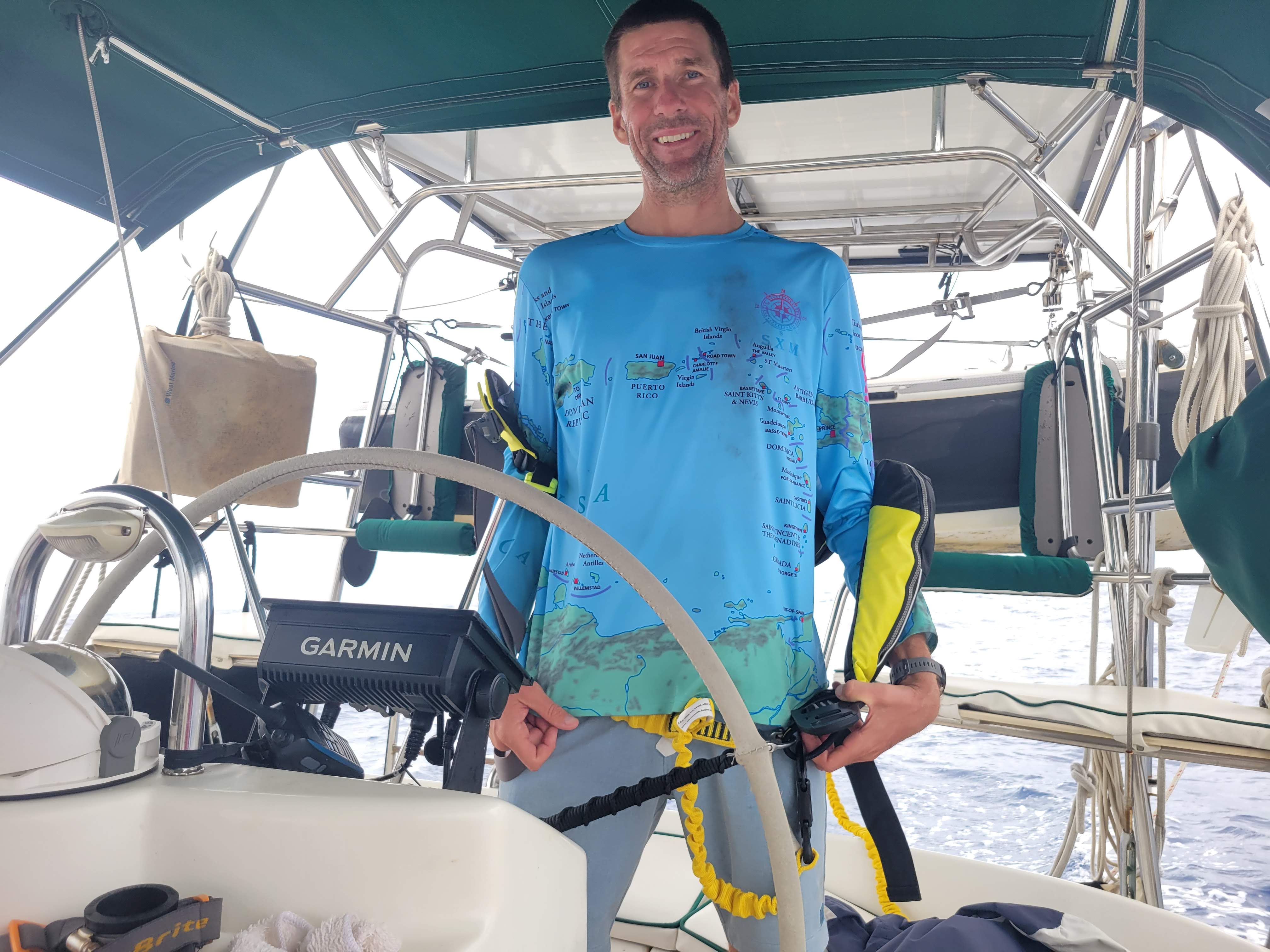
The day before we made landfall, we got back into charted waters and she let it go, until she needs some juicy dig in our next argument.
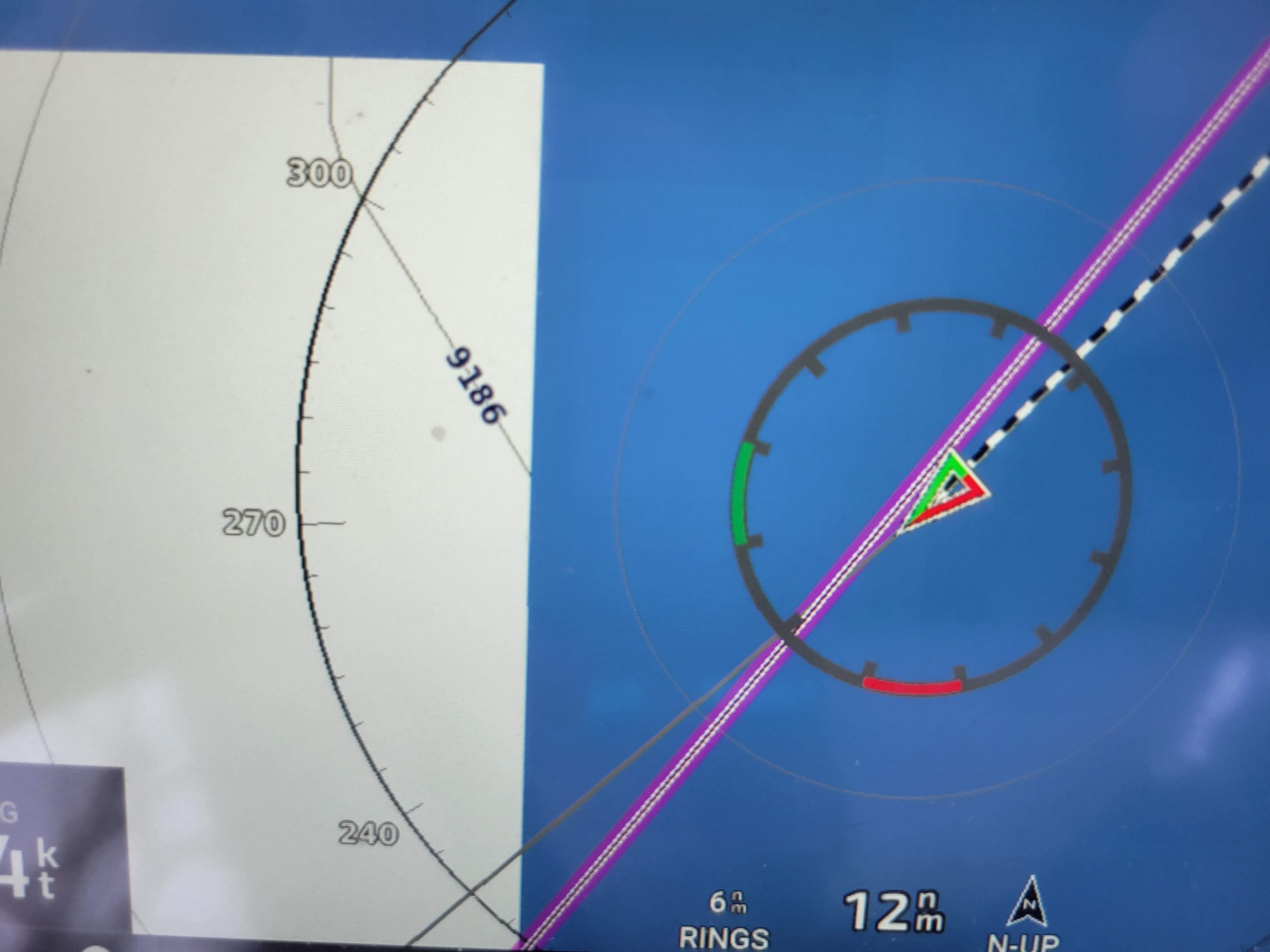
Headsail Woes
When the wind got really light, I decided we would try to use our Spinnaker pole to hold the Genoa out. It’s a tactic that is commonly used in light winds and can add significant efficacy to the sail. We’ve never done it before so I didn’t figure we would do it successfully but it was quite calm and we still had 150 miles to go so it seemed like a great time to fiddle around with it to try to learn what I don’t know.
After about ten minutes of messing around with all the bits, I decided to give up on it for now. We rolled the headsail back in and I noticed that the furling foil didn’t look right. It seems that somehow, at some point, the retaining bolts had come out and the headsail is in a state that it should no longer be used until I get new bolts and install them.
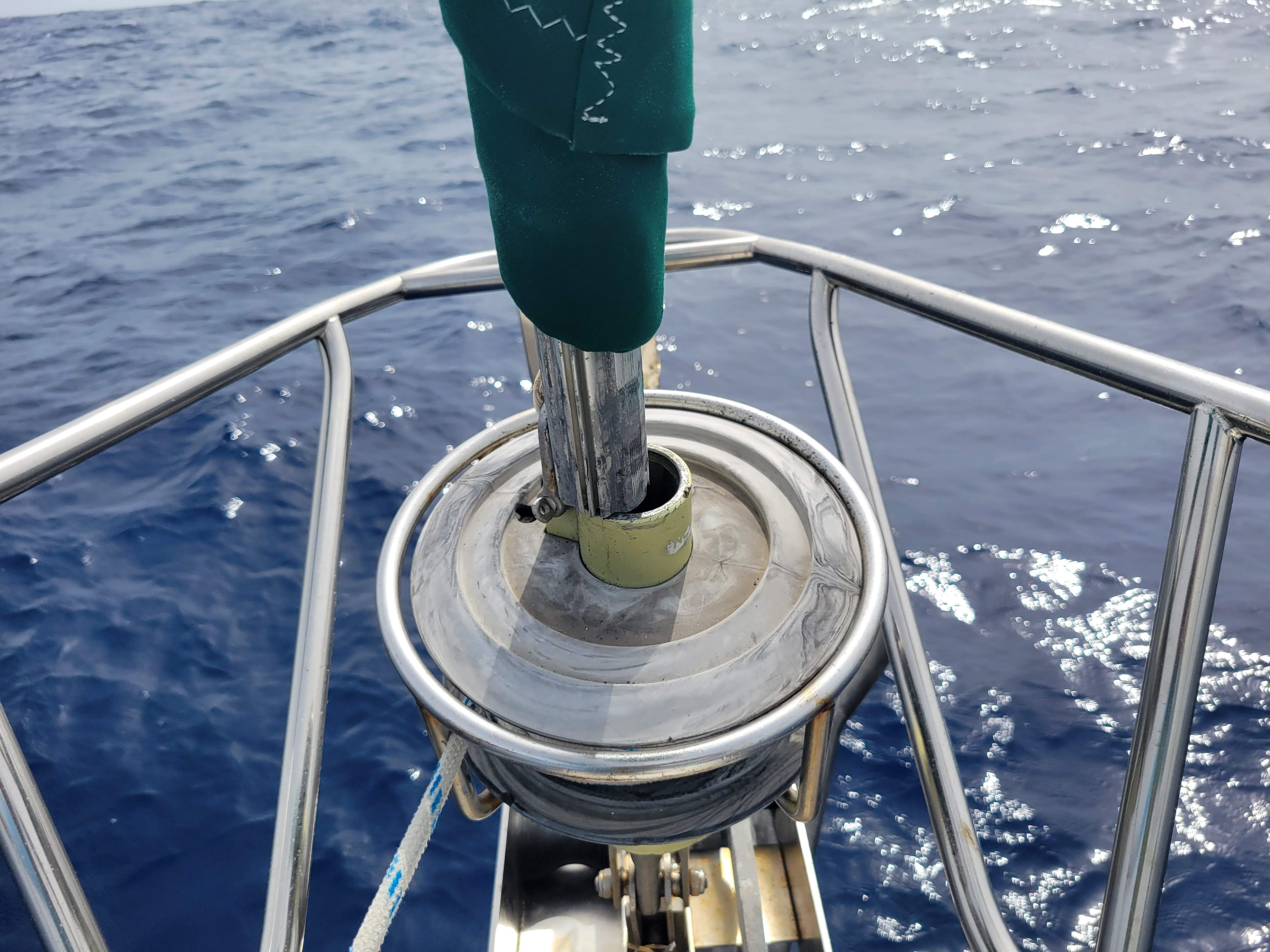
Luckily we were near the end of the sail and the wind sucked anyway. It’s a good thing I decided to go play around with things though because if we hadn’t spotted the issue we could very well have caused some damage if we continued using the headsail normally. Add it to my long list of maintenance to get at in Panama.
MAS
Do not read this section if you are easily disgusted, offended, or have any respect at all for me. Skip below.
START OFFENSIVE CONTENT
OK, since we’re all still here, we’ll talk about filth and MAS. Every boat does things differently for maintaining grooming standards while underway. We do away with flossing underway, and just brush. We also do away with showers underway. Not a huge deal for 1-2 day passages but it got a bit nasty after 6+ days. Surprising not that bad though. I think the cool temperatures of the high winds really kept things at bay. The salt and sweat did pile up though so obviously, when we arrived in port, swimming and showers went to all of the crew.
Now, what is MAS? Well, sometimes stuff is much funnier if/when you are there. I’m sure this is one such thing, but I am trying to keep an accurate record of our time on Sea Hoss to entertain old-man me in a couple of decades so here goes. We have high density foam cushions in our cockpit, and they are great. They don’t absorb water at all and are soft enough that you don’t get sore butt bones, even after days at sea.
With following seas and wind, the boat always has a significant amount of rolling back and forth, sometimes quite forcefully. So, when seated upright on high density foam and getting thrashed back and forth for 145 hours, it generally feels like the world is trying to smash and rip your asshole apart 18 hours a day. Mashed Asshole Syndrome is thus the condition that results from days upon days of the beating one’s anus takes in these seas.
It is really clear when it is most heavily impacting someone since they tend to sit on one butt cheek leaned heavily to one side. It hurts and there is basically no getting away.
Sorry about this section.
END OFFENSIVE CONTENT
Visitors
Now on to something funner and more family friendly. We had visitors. One morning Fira and I both saw a shark surfacing near our bow. First time we saw one underway. It was about 8 feet or so, so no Jaws moments of tension or anything, just a cool sighting.
We had two pods of dolphins visit us as well a few days apart. No matter how many times we see dolphins they lift everyone’s spirits every single time. The first pod had one dolphin that did a flip off the top of an eight foot wave which the kids totally loved. The second pod stuck around a bit longer and had 20-30 that showed their fins.
Sleepovers
One night right before sunset we had a visitor. A big Boobie landed on our port side deck. It just kind of looked around and didn’t seem too concerned. Then after ten minutes or so, it started really making itself comfortable. Eventually, it tucked its head into its wings for a nice nap.
Soon after the sun went down and it got darker. We continued sailing on through the night which was uneventful. When the sun came up in the morning, the Boobie was still asleep on our side deck. It was pretty ridiculous. About an hour or so after the sun came up it decided it was time to shove off. The trouble is that the bird tried to fly away right under our gate stanchion. When it leaned forward to take off it opened up its wings and caught itself in a full-nelson that it couldn’t escape from.
Grete to the rescue. She went over to the bird and helped it free up its wings so it could go back to life on the open sea.
The next night, word had gotten out that our boat is a great place to sleep. We sailed through the night and awoke in the morning to ten or so flying fish that had enjoyed some rest aboard :(
Getting Close
As we got close, our fun with currents and good wind went away and was replaced with crappy sailing. As the wind let up our sails had a harder and harder time staying full and we slowed down from our crazy speeds to just normal speeds. Then, the wind finally got weak enough that we fired up the engine and drove the remaining 32 hours or so to Bocas del Toro. For the final approach to Bocas, the current began sweeping from right to left and pulled us off course as well as slowed us down quite a bit. I revved up the engine a lot and we pushed across the 30-40 mile wide river of seawater that was like a mini Gulf Stream.
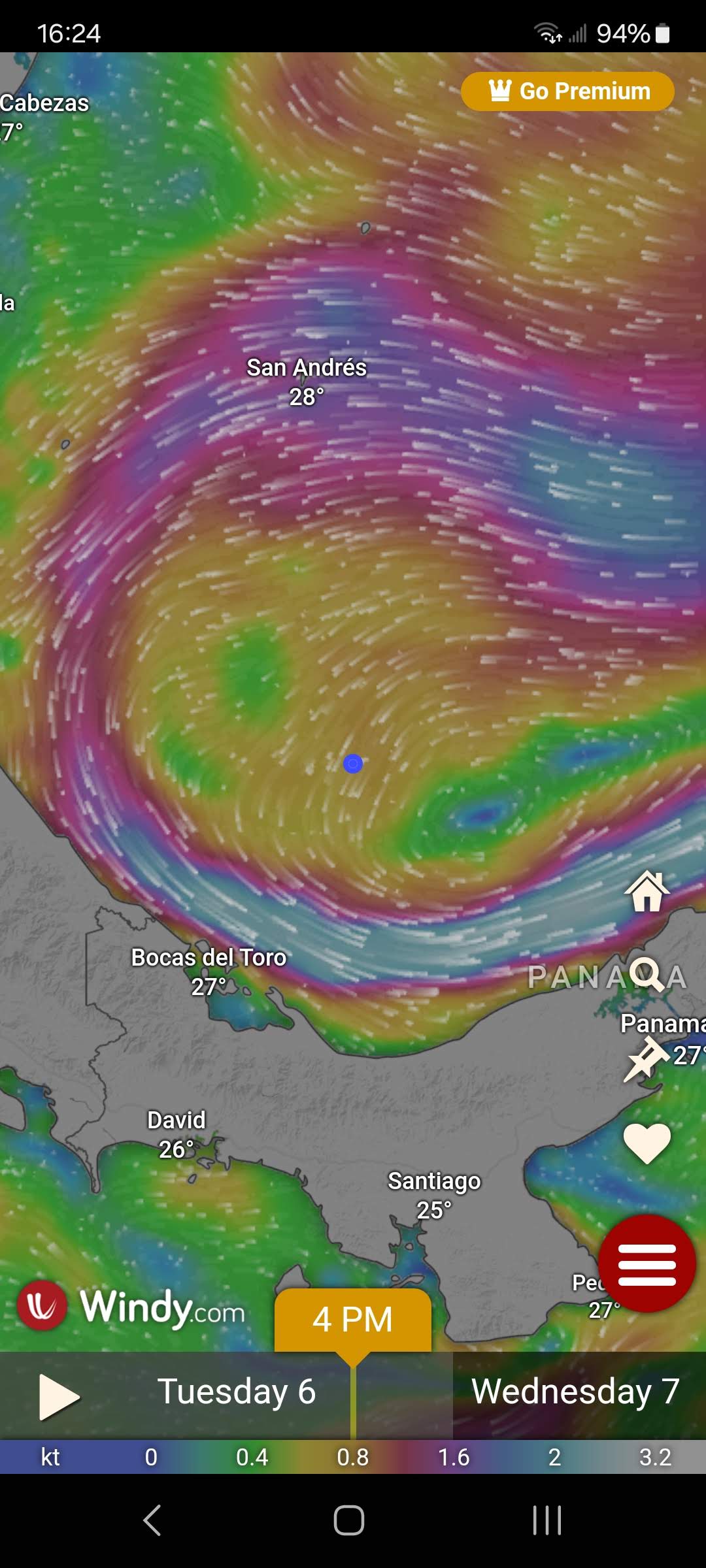
We were still too far away to see Panama when the sun went down so when the sun came up in the morning we were greeted with a beautiful sunrise that lit up our new home for us.
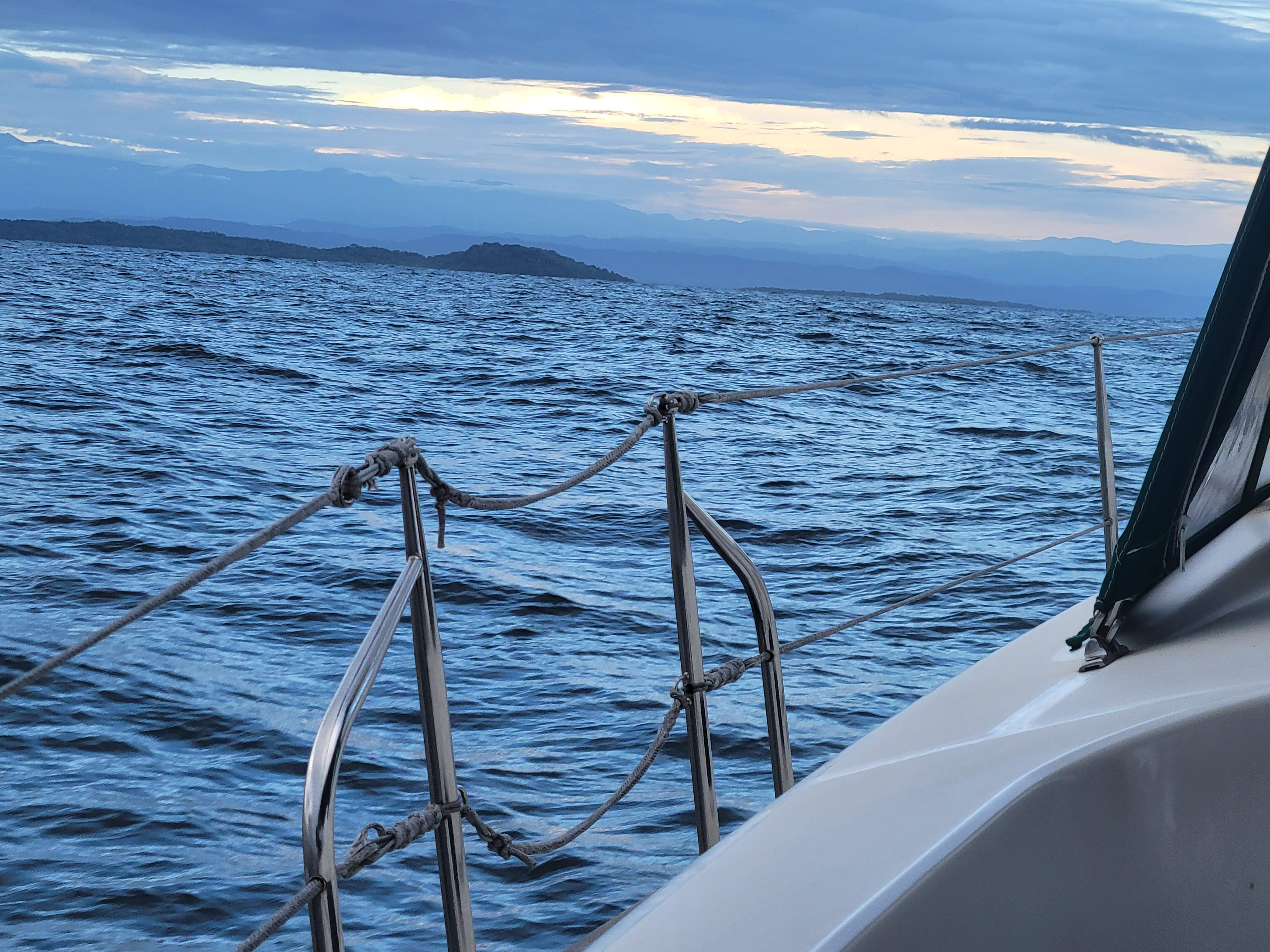
We arrived and set the anchor after 145 hours underway, a bit bedraggled, quite filthy, and in awe of the stunning landscape. It was early in the morning and we were exhausted. In lieu of a “here beer”, I opted for a “here coffee”. It was my first cup in a week and it was perfect.
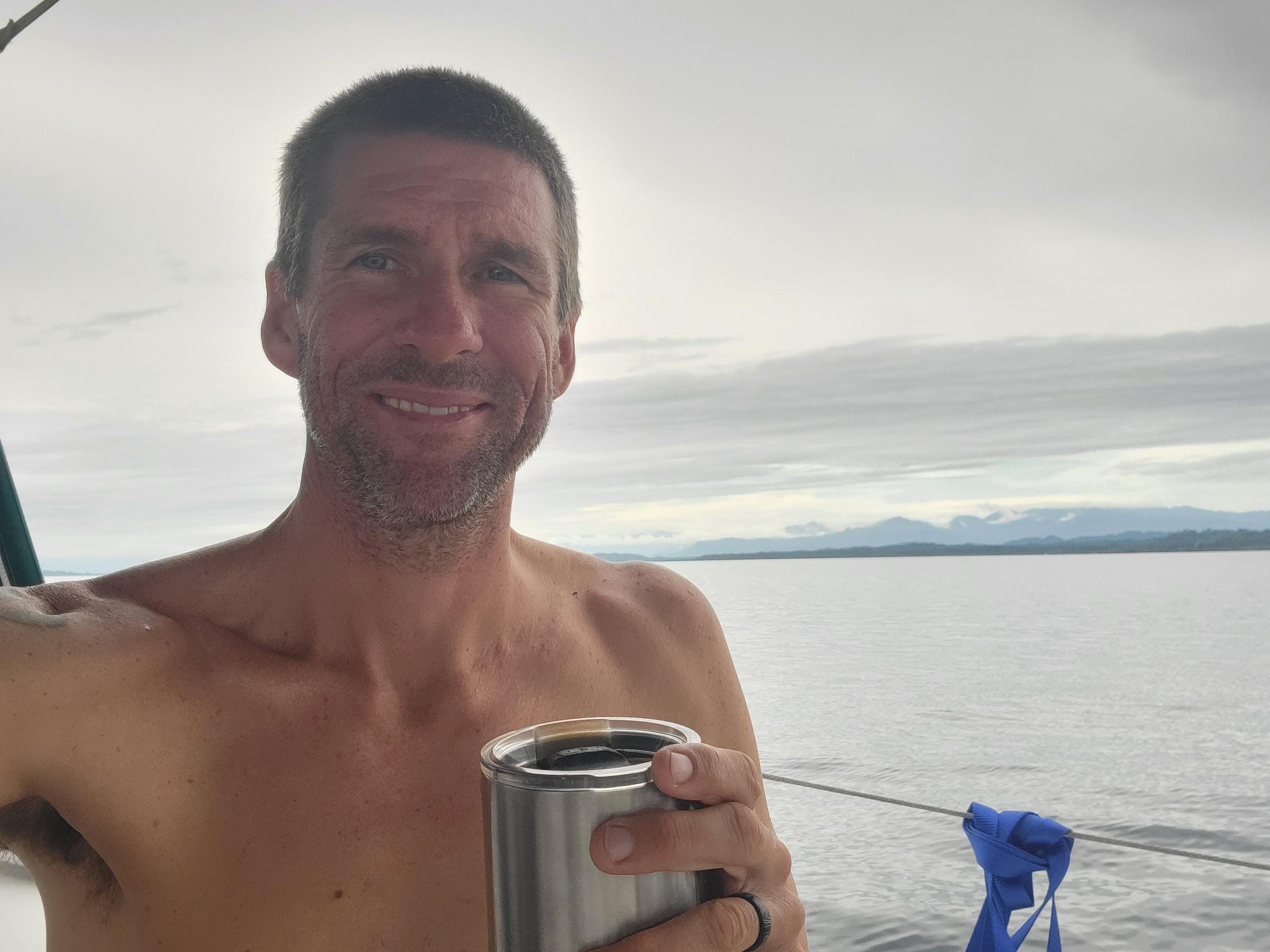
Decisions, Decisions
So, now we’ve hit our next major milestone and it’s time to start thinking about what lies ahead for us. We have waffled about whether we want to undertake a Pacific crossing, or maybe just stay in the Caribbean. We are leaning toward the majesty of the South Pacific, but it will certainly be a lot of work to get ready as well as a 4,000 mile passage from Panama to the Marquesas (so much MAS), so we are not 100% certain either way yet. It is also possible we’ll spend a year on the west coast of Mexico before making the jump across the Pacific. Doing so would give us another year of experience, completely different cruising grounds from where we’ve been and might go, and also has the ancillary benefits of shortening the trip to French Polynesia by 1,000 miles and keeping us closer to family for another year. Regardless of what we decide, we have several months in Panama so for now we plan to slow down, visit friends, enjoy a visit from Aunt Inge and Muddah Goose next month and see what unfolds.
